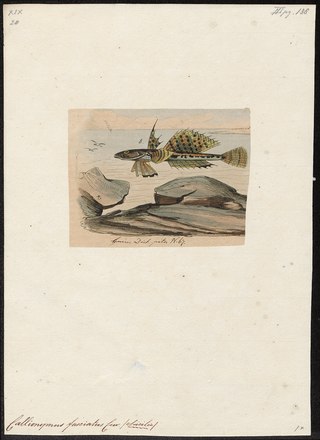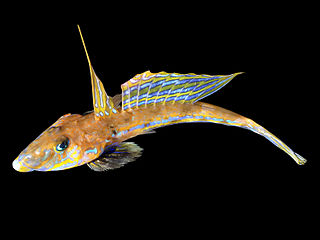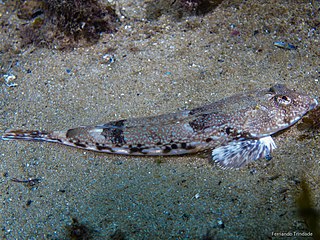
Dragonets are small, percomorph, marine fish of the diverse family Callionymidae found mainly in the tropical waters of the western Indo-Pacific. They are benthic organisms, spending most of their time near the sandy bottoms, at a depth of roughly two hundred meters. There exist 139 species of the fish, in nineteen genera.

The sergeant major or píntano is a species of damselfish. It grows to a maximum length of about 22.9 centimetres.

The orange-spotted grouper, also known as the brown-spotted rockcod, estuary cod, estuary rockcod, goldspotted rockcod, greasy cod, North-west groper, orange spotted cod or blue-and-yellow grouper, is a species of marine ray-finned fish, a grouper from the subfamily Epinephelinae which is part of the family Serranidae, which also includes the anthias and sea basses. It has an Indo-Pacific distribution and is found in marine and brackish waters.

The two-spotted goby is a species of goby native to marine and brackish waters of the eastern Atlantic Ocean where it can be found from the Faeroes and Norway to the northwestern coast of Spain. It has also been recorded from Estonia though records from the Mediterranean Sea are uncertain. They are common on all coasts of the United Kingdom. This species can reach a length of 6 centimetres (2.4 in) TL.

The greater amberjack, also known as the allied kingfish, great amberfish, greater yellowtail, jenny lind, Sea donkey, purplish amberjack, reef donkey, rock salmon, sailors choice, yellowtail, and yellow trevally, is a species of predatory ray-finned fish in the family Carangidae, the jacks and pompanos. It is found in temperate, subtropical, and tropical seas around the world. It is a popular quarry species for recreational fisheries and is important in commercial fisheries. It is the largest species in the family Carangidae.

Chromis chromis, the damselfish or Mediterranean chromis, is a small species of ray-finned fish of the family Pomacentridae from the Eastern Atlantic and Mediterranean.

The ornate wrasse is a species of wrasse native to the rocky coasts of the eastern Atlantic Ocean and the Mediterranean Sea. This species, commonly known as the circus fish, is of minor importance to local commercial fisheries, is also popular as a game fish, and can be found in the aquarium trade.

The lancer dragonet, Baird's dragonet, coral dragonet or St Helena dragonet, is a species of dragonet native to the warmer waters of the Atlantic Ocean where it occurs at depths of from 1 to 91 metres. In the western Atlantic it occurs from Cape Hatteras southwards along the east coast of North America. including Bermuda and the Bahamas, into the Gulf of Mexico and throughout the Caribbean Sea. It has also been recorded from Ilha da Trindade off Brazil. In the eastern Atlantic it has been recorded from the Cape Verde Islands, Ascension Island, St. Helena, and Sao Tome e Principe in the Gulf of Guinea. This species grows to a length of 11.4 centimetres (4.5 in) TL.
Callionymus belcheri, Belcher's dragonet or the flathead dragonet, is a species of dragonet native to the Pacific Ocean waters off of Australia and Papua New Guinea where it occurs at depths of from 18 to 36 metres.

The banded dragonet is a species of dragonet native to the Mediterranean Sea from the Gulf of Genoa to the western Aegean Sea. Also known from the southern and eastern Black Sea. It prefers sandy substrates where its diet consists of benthic invertebrates.

The common dragonet is a species of dragonet which is widely distributed in the eastern North Atlantic where it is common near Europe from Norway and Iceland southwards. It is a demersal species that occurs over sand bottoms. It lives to a maximum age of around seven years. It is caught in bycatch by fisheries and is used in the aquarium trade.
The spotted dragonet is a species of dragonet native to the eastern Atlantic Ocean and the Mediterranean Sea where it occurs at depths of from 45 to 650 metres. This species is important to local peoples engaged in subsistence fishing.

The reticulated dragonet is a species of dragonet native to the northeastern Atlantic Ocean and the Mediterranean Sea where it is found at depths of from 0 to 110 metres. This species grows to a length of 11 centimetres (4.3 in) TL. This species has a flattened head and body, the head has a triangular shape with the eyes placed on the top of the head. It has two dorsal fins with the first one being triangular in shape. It has blue spots along the flanks and four saddle-like markings on their backs which have sharply defined outlines. It is similar to the common dragonet but is distinguished by its smaller size and the sharply defined border around the saddle markings on the back.

Risso's dragonet is a species of dragonet native to the Mediterranean Sea as well as the Black Sea and rarely found off of Portugal in the Atlantic Ocean. This species can be found at depths of from 15 to 150 metres. Males of this species grows to a length of 11 centimetres (4.3 in) TL while females reach a length of 6.5 centimetres (2.6 in).

Lipophrys pholis, commonly known as shanny, also known as the smooth blenny or common blenny, is a species of combtooth blenny. It matures at two years of age. Distributed in the Eastern Atlantic from the southern Norway to Morocco and Madeira, including the Mediterranean and the Balearics. Lipophrys pholis feed primarily on crustaceans, but also feed on other invertebrates and plants.

Montagu's blenny, also known as the capuchin blenny, is a species of combtooth blenny found in the intertidal zones of the eastern Atlantic ocean from England to Madeira and the Canary Islands as well the Mediterranean Sea, the Black Sea and the Sea of Marmara. This species prefers rocky shores with much wave action. This species grows to a length of 7.6 centimetres (3.0 in) SL. It is the only species in the genus Coryphoblennius.
Clinitrachus argentatus, the cline, is a species of clinid found in shallow waters of the eastern Atlantic and the Mediterranean Sea. This species feeds primarily on benthic invertebrates. This species is currently the only known member of its genus.

Synapturichthys kleinii, Klein's sole or lace sole, is a species of economically important sole. It is the only known member of its genus.
Arnoglossus imperialis, the imperial scaldfish, is a species of flatfish from the family of left-eyed flounders, the Bothidae. It occurs in the eastern Atlantic from Scotland south to Namibia, extending into the western Mediterranean. This bottom dwelling species is sometimes caught as bycatch but is of little interest to fisheries.

Synchiropus phaeton or the Phaeton dragonet is a species of bony fish of the family Callionymidae, the dragonets. It can be found in the Mediterranean and in the eastern Atlantic.















